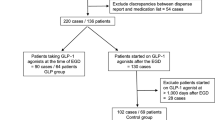Abstract
Purpose
To evaluate the efficacy of a proton pump inhibitor, we retrospectively reviewed patients who underwent gastric fiberscopy (GFS) in the early phase after cardiac surgery.
Methods
The subjects were 103 patients who underwent GFS for poor appetite, gastric pain, heartburn, or hematemesis after cardiac surgery. We divided the patients into two groups: group I consisted of 49 patients who received an H2-receptor antagonist (ranitidine hydrochloride 300 mg/day), and group II consisted of 54 patients who received a proton pump inhibitor (PPI; sodium rabeprazole 10 mg/day) as prophylactic treatment. The incidence of upper gastrointestinal (GI) disease was compared in the two groups.
Results
Gastric fiberscopy confirmed that 82.5% of the patients had type I hiatal hernia. The incidences of gastric pain and heartburn were significantly higher in group I (12.2% and 83.7%) than in group II (0% and 37.0%). Moreover, gastric bleeding occurred in two patients from group II, one of whom died of coagulopathy. The incidences of hemorrhagic gastritis, active ulcer, and reflux esophagitis were significantly higher in group I than in group II, at 22.4%, 22.4%, and 24.5% vs 1.9%, 0%, and 7.4%.
Conclusions
Early postcardiotomy GFS confirmed a high incidence of type I hiatal hernia. However, the proton pump inhibitor given in the early postoperative period proved more effective than the H2-receptor antagonist for relieving GI symptoms and preventing upper GI disorders after cardiac surgery.
Similar content being viewed by others
References
MJ Grap L Savage GB Ball (1996) ArticleTitleThe incidence of gastrointestinal symptoms in cardiac surgery patients through six weeks after discharge Heart Lung 25 444–50 Occurrence Handle1:STN:280:ByiC3cjjslI%3D Occurrence Handle8950123
PJ Kahrilas AE Spiess (1999) Hiatus hernia DO Castell JE Richter (Eds) The esophagus EditionNumber3rd ed. Lippincott Williams & Wilkins Philadelphia 381–96
N Furukawa R Iwakiri T Koyama K Okamoto T Yoshida Y Kashiwagi et al. (1999) ArticleTitleProportion of reflex esophagitis in 6010 Japanese adults: prospective evaluation by endoscopy J Gastroenterol 34 441–4 Occurrence Handle10.1007/s005350050293 Occurrence Handle1:STN:280:DyaK1MznvFOnsQ%3D%3D Occurrence Handle10452674
RK Mittal DF Rochester RW McCallum (1989) ArticleTitleSphincteric action of the diaphragm during a relaxed lower esophageal sphincter in humans Am J Physiol 256 G139 Occurrence Handle1:STN:280:BiaC3czltVQ%3D Occurrence Handle2912145
A Berstad R Weberg I Froyshov Larsen B Hoel M Hauer-Jensen (1986) ArticleTitleRelationship of hiatus hernia to reflux oesophagitis. A prospective study of coincidence, using endoscopy Scand J Gastroenterol 21 55–8 Occurrence Handle1:STN:280:BimC2M7js1M%3D Occurrence Handle3952452
DJ Ott DW Gelfand YM Chen WC Wu HA Munitz (1985) ArticleTitlePredictive relationship of hiatal hernia to reflux esophagitis Gastrointest Radiol 10 317–20 Occurrence Handle1:STN:280:BimD3s7gslE%3D Occurrence Handle4054494
D Cook G Guyatt J Marshall D Leasa H Fuller R Hall et al. (1998) ArticleTitleA comparison of sucralfate and ranitidine for the prevention of upper gastrointestinal bleeding in patients requiring mechanical ventilation N Engl J Med 338 791–7 Occurrence Handle10.1056/NEJM199803193381203 Occurrence Handle1:CAS:528:DyaK1cXitlChtbg%3D Occurrence Handle9504939
U Halm F Halm D Thein FW Mohr J Mossner (2000) ArticleTitleHelicobactor pylori infection: a risk factor for upper gastrointestinal bleeding after cardiac surgery Crit Care Med 28 110–3 Occurrence Handle1:STN:280:DC%2BD3c7ivV2ksg%3D%3D Occurrence Handle10667508
PH van der Voort DF Zandstra (2000) ArticleTitlePathogenesis, risk factors, and incidence of upper gastrointestinal bleeding after cardiac surgery: is specific prophylaxis in routine bypass procedures needed? J Cardiothorac Vasc Anesth 14 293–9 Occurrence Handle1:STN:280:DC%2BD3M%2FgvFKntA%3D%3D Occurrence Handle10890484
T Yao T Matsui A Motomura Y Takeyama T Sakurai K Maeda et al. (1994) ArticleTitleAn evaluation of the clinical efficacy of the proton pump inhibitor E3810 (rabeprasol sodium) for treating intractable ulcers Mod Phys 14 85–9
JQ Huang RH Hunt (1996) ArticleTitlepH, healing rate and symptom relief in acid-related diseases Yale J Biol Med 69 159–74 Occurrence Handle1:CAS:528:DyaK2sXivFentrs%3D Occurrence Handle9112748
S Ohara M Hongo S Asaki A Satoh D Shibuya H Satoh et al. (1989) ArticleTitleThe effects of famotidine and omeprazol on 24-h intra-gastric pH of normal subjects Jpn J Gastroenterol 85 1353–9
PC Taylor FD Loop RE Hermann (1973) ArticleTitleManagement of acute stress ulcer after cardiac surgery Ann Surg 178 1–5 Occurrence Handle1:STN:280:CSyB3MnhtFM%3D Occurrence Handle4541549
Author information
Authors and Affiliations
Additional information
An erratum to this article is available at http://dx.doi.org/10.1007/s00595-007-3473-0.
Rights and permissions
About this article
Cite this article
Hata, M., Shiono, M., Sekino, H. et al. Efficacy of a Proton Pump Inhibitor Given in the Early Postoperative Period to Relieve Symptoms of Hiatal Hernia After Open Heart Surgery. Surg Today 36, 131–134 (2006). https://doi.org/10.1007/s00595-005-3108-2
Received:
Accepted:
Issue Date:
DOI: https://doi.org/10.1007/s00595-005-3108-2




